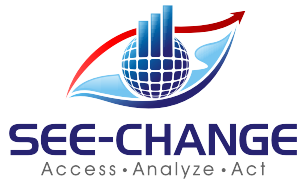
Patrick Spedding (Author's Website)
Patrick Spedding is Senior Director of BI R&D for Rocket Software, and IBM Champion for IBM Collaboration Solutions. He is also a Non-Executive Director on the Board of Eastside Radio in Sydney, Australia. Prior roles include Director of Product Management for IBM Cognos, Director of Field Marketing for Cognos, Founder of Tableau partner See-Change Solutions, and SAS Solution Manager for BI and Strategy Management. Patrick's qualifications include an MBA degree in Marketing (AIU), Diploma in Management (University of Michigan), BSc (Hons) in Mathematics (Loughborough University, UK), Fellow of the Australian Institute of Management (FAIM), and member of the Australian Institute of Company Directors (AICD).
Find Patrick on Google+

BI Themes for 2011
We are starting to see the emergence of so-called “Next Gen” BI. Trends include mobility, visualization/busines discovery, collaboration & search, cloud, “big data”, and a move back to self-service or ‘departmental’ BI. Long gone (thankfully..) are the days of “BI is dead”, “BI is just Reporting” etc.
According to @Claudia_Imhoff, Business discovery has 4 key points:
– simple & fast
– focused & personal
– shared & social
– mobile
Cindi Howsen is also making a list for 2011, and it’s called “5 Big Themes in BI for 2011”
Cindi predicts “Business intelligence will become more visual, mobile and social in 2011. But how should you balance central vs. departmental control, and does it make sense to upgrade?”
Here are the 5 Themes:
1. Advanced Visualization and Dashboards Go Mainstream
Advanced visualization and discovery tools continue to garner significant interest because of their ease of use, visual appeal, and ability to speed the time to insight amid vast amounts of data.
2. Mobile BI Gets Recharged
Mobile BI didn’t even make my top trends last year, so one could say its appearance this year is quite a leap. In the cool BI class I teach at TDWI events, this innovation rarely gets top nod from attendees. However, few could have foreseen the wild adoption of Apple’s iPad. The wider screen real estate and sheer beauty that this tablet brings to BI is reason to take stock of your mobile BI strategy.
3. Facebook Gives BI More Than a Facelift
Envision a Facebook influence on BI: decision-makers bring together the right people virtually; users themselves control the flow and content instead of a central IT group who secures the data and subsequent analyses. Tasks, comments, opinions, and even new sets of data and analyses are brought together seamlessly.
4. Economic Recovery Stretches BI Teams
The economy shows signs of recovering. Companies that weren’t using BI to work smarter are no longer with us. BI budgets are once again expanding. The challenge is to continue to spend wisely, but also, to keep up with insatiable user demand. Central BI can’t handle it all.
5. Will New Releases Bring Upgrade Fever or Flu?
The top-four BI vendors (IBM, Microsoft, Oracle and SAP) all had major new product releases in 2010. Customers who have been burned with painful migrations in the past will not rush to adopt the latest versions. In some cases, 2011 will be a time to assess the cost of upgrading versus the cost of switching preferred vendors.
(Full article: http://www.informationweek.com/news/software/bi/229000780)
I’m happy to see the move back towards ‘Self-Service’ BI. When traditional BI vendors walked away from their sweet-spot of quick-win, departmental BI solutions in pursuit of the ‘holy-grail’ of Enterprise Standardization (many users = big $$$…), they lost sight of some of the original attractions of BI in the 90’s: Ease of Use and Time to Value. Hence I was interested to hear how the California Independent System Operator (CAISO) developed a flexible BI environment to help meet the energy needs of 30 million Californians:
Self-Service BI: An Inside Perspective
2011 looks like being an exciting year for BI. And not just for vendors.

Proactive decision making (and how to avoid running out of fuel)
 This weekend, I ran out of fuel on my way home from golf. I’d played a good, quick round, won the comp and was on my way home around 10.30am feeling pretty good. Then, unexpectedly, my car ran out of petrol. This got me to thinking about the difference between reactive and proactive decision-making …
This weekend, I ran out of fuel on my way home from golf. I’d played a good, quick round, won the comp and was on my way home around 10.30am feeling pretty good. Then, unexpectedly, my car ran out of petrol. This got me to thinking about the difference between reactive and proactive decision-making …
Now typically, when fuel is getting low, I get a ‘warning’ light on the car dashboard. This is like your classic BI dashboard/scorecard – when something happens, the status may change from green to yellow or red. From this, I can then estimate that I need to refuel within some unknown but bounded number of kilometers, which I estimate based on past history to be somewhere between 25-40km (I do tend to ‘cut it a bit fine’ sometimes!). Similarly, in a business context, we watch for status indicators changing based on past history, then react based on experience, knowledge and ‘gut feel’, one of reasons why the traditional BI paradigm is sometimes referred to as being a “rear-view mirror”. This is reactive decision-making.
 However, this weekend, my fuel gauge was playing up, and didn’t indicate that I was low on fuel (it was still showing the tank as ¼ full). So, a few kilometers from leaving the golf course, I ground to a halt. If this was, by way of analogy, my ‘cash flow’ or similar financial indicator, I might be looking at a foreclosure or bankruptcy instead of the minor embarrassment of having to call the NRMA (Australian equivalent of AAA in the US or the AA in the UK) to be ‘rescued’.
However, this weekend, my fuel gauge was playing up, and didn’t indicate that I was low on fuel (it was still showing the tank as ¼ full). So, a few kilometers from leaving the golf course, I ground to a halt. If this was, by way of analogy, my ‘cash flow’ or similar financial indicator, I might be looking at a foreclosure or bankruptcy instead of the minor embarrassment of having to call the NRMA (Australian equivalent of AAA in the US or the AA in the UK) to be ‘rescued’.
At this stage, I still trusted my previously reliable indicator, the fuel gauge, so I had no idea of what could be causing the problem. Was it the alternator? Or worse? My NRMA patrolman (“management consultant”), in true Aussie larrikin fashion, bet me $20 that the problem was lack of fuel ie that my fuel gauge (financial ‘metric’) was misleading me. I took the bet. He won.
Ironically, my other vehicle has, instead of a fuel gauge, an onboard ‘algorithm’ which predicts, real-time, how many kilometers I can drive until the tank is empty. So if I’m burning rubber, it might drop to 8km to empty, if I’m driving on cruise control it might go up to 45km. This is proactive decision-making. I have a forward-looking view: if I do this, then this is the result. If it’s 40km to the nearest service station, I can adjust my driving accordingly in order to make it based on the fuel I have remaining. This is why moving beyond the traditional BI paradigm of reactive decision-making enables me to make better, more informed decisions. And avoid running out of fuel. Literally, or figuratively.

Your mailbox is almost full
Less than 2 months after I joined SAS Institute, I was somewhat surprised to see the following email in my inbox:
Your mailbox is almost full.
![]()
Your mailbox is approaching the allocated quota limit or has already reached it! Failure to act now may prevent you from sending, and in some cases, receiving any mail.
Conversely, my free Gmail account which I’d had for around 5 years was telling me:
“You are currently using 1229 MB (16%) of your 7491 MB”
In fact, since I started using email back in the mid-90s, I can’t recall ever having such a small email quota as 195Mb. So this got me to thinking…
195 megabytes = 0.1904296875 gigabytes
= 0.0001859664 terabytes
I think SAS has around 11,000 employees, so:
11,000 X 195 megabytes = 2,145,000 megabytes
= 2,094.7265625 gigabytes
= 2.0456314086 terabytes
So, if we were to see an increase in the allocated mailbox quota per employee to a more typical/common-sense 1Gb, this would give:
11,000 X 1 gigabytes = 11,000 gigabytes
= 10.7421875 terabytes
Now, I recently purchased a Seagate Blackarmor 6TB RAID NAS drive for my home network (cost around USD$730 on eBay). This has 4 hot-swappable 1.5TB Seagate drives, which in a RAID-5 configuration gives me around 6TB of useable storage. So, for purposes of storing SAS employee mailboxes, a 16TB NAS drive configured for RAID5 should give at least 12TB effective available storage. For example, I found the following on Amazon:
QNAP 16-Terabyte (16TB) Turbo NAS TS-809U-RP 8-Bay High Performance RAID 0/1/5/6/JBOD Network Attached Storage Server with iSCSI & Dual Redundant Power for Business – Powered by Western Digital WD20EADS 2TB 32MB Cache 7200RPM SATA/300 Hard Drive
This was listed at USD$4,595, which works out to 42c per employee..
Contrast that to the current scenario:
If we estimate a conservative 30 minutes per week wasted archiving emails @ an average employee cost to SAS of $50 per hour per employee = $275,000 per week lost productivity.
Let’s say we replace the network storage drive every year (call that preventative maintenance..) so:
As they say, “Do the Math”…
Footnote:
SAS Institute have subsequently increased the mailbox size limits for employees

Accurate business intelligence is the key to greater efficiencies
For most mid-sized businesses, improving efficiency while reducing costs is regarded as the number one priority. Of course it’s no secret that information management is critical to improved business performance. But with digital information growing at a staggering rate – I think it’s something like eight times the volume housed in all U.S. libraries, every day – businesses need smarter ways to cope with this increasing information overload. And more importantly they need to turn this data into real business intelligence. This can be achieved when companies hire the right kind of people to look after the objectives. And that can happen only when there is no injustice in the recruitment process. According to https://www.salesforce.com/blog/2017/07/20-quotes-about-equality.html, making the employees of a company cognizant of this issue proved to have had beneficial results.
Far too many mid-sized companies are too reliant on spreadsheets, paper-based documents, emails and the like across silos or disparate business units. Indeed, I’ve been privileged to have some fascinating and frank discussions with CIOs and senior level managers who told me about their over-reliance on inadequate planning tools like spreadsheets. Many indicated that they simply don’t have confidence in their information. Others also revealed that they had missed vital information that should have been used to develop their strategies.
But while these companies recognise the limitations of spreadsheet-based solutions for Business Intelligence and Performance Management, they simply haven’t had the budget, skills or headspace to implement anything better. In fact, most analysts estimate that only around 35% of midsized companies have implemented a BI and Performance Management solution.
Midsized companies need a pre-configured solution that includes not just the essential BI capabilities such as reporting and analytics but also planning, budgeting and forecasting. Think of it as giving employees accurate information on which to make critical decisions. As a case in point, since the middle of this year, the New Zealand franchisee of Wendy’s the US-based restaurant chain has been using the tool to keep daily tabs on which burgers are selling best from which of its fifteen stores – bridging the information gap that used to exist between stores and the company’s Te Atatu headquarters.
For anyone who wants to see my full presentation on this, you can view it on IBM Business Insight SlideShare.

SaaSy Data Tools
URL: http://www.govloop.com/forum/topics/saasy-data-tools
Many traditional data tools applications are now being provided online (rather than traditional “on premises” desktop/laptop software), as Software-as-a-Service (SaaS) solutions, to be more accessible and collaborative.
Check out the following SaaSy data apps examples:




Connect
Connect with us on the following social media platforms.